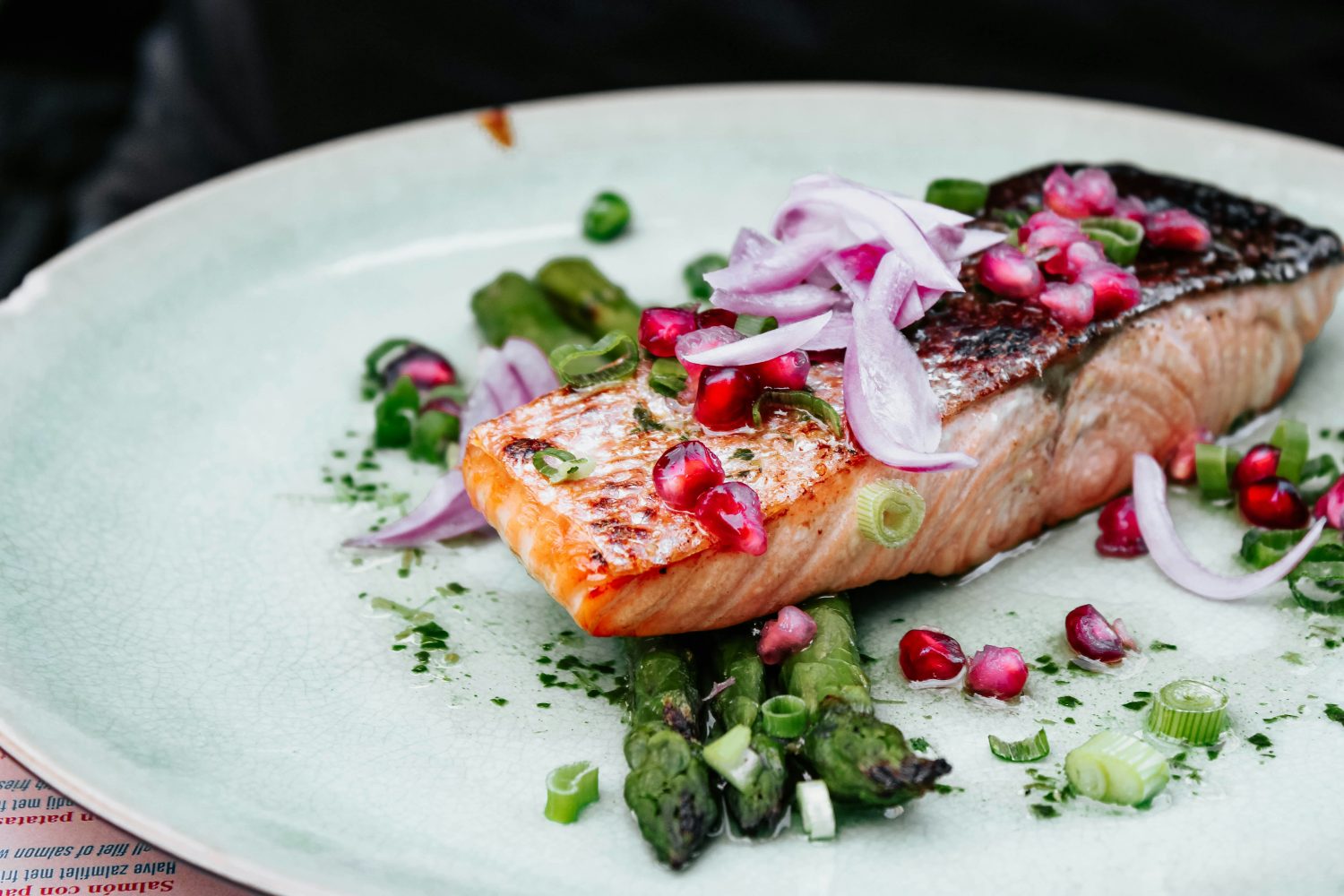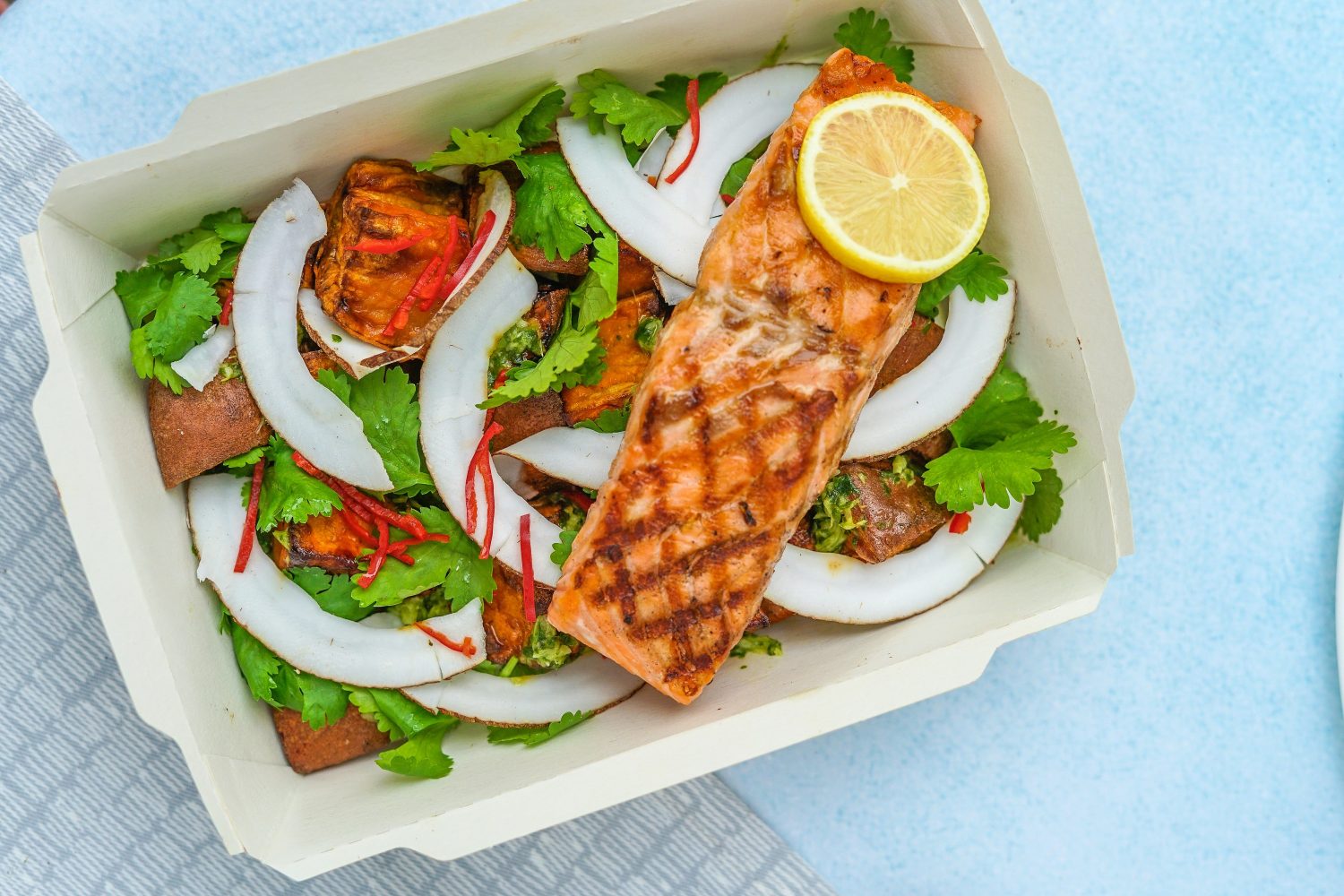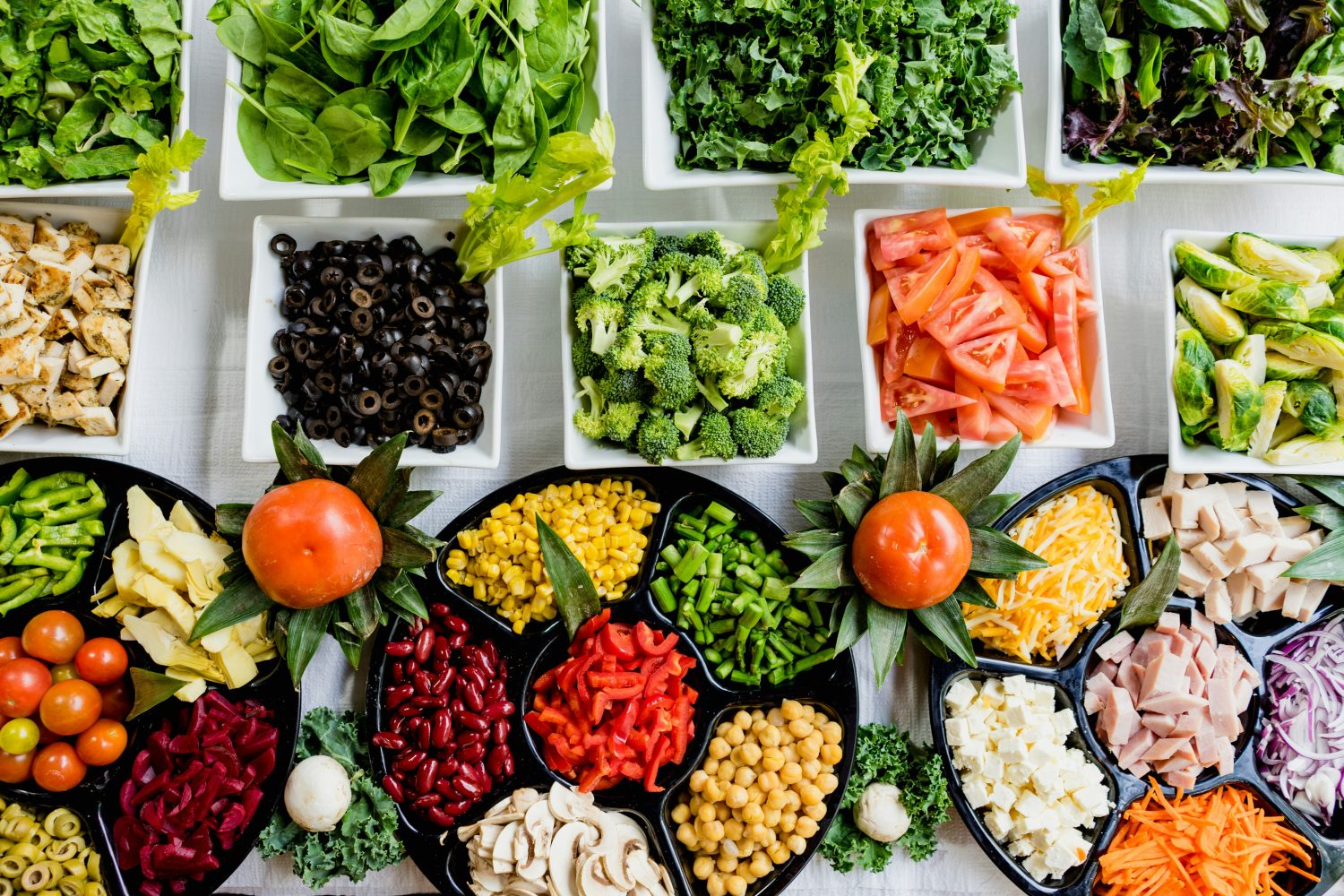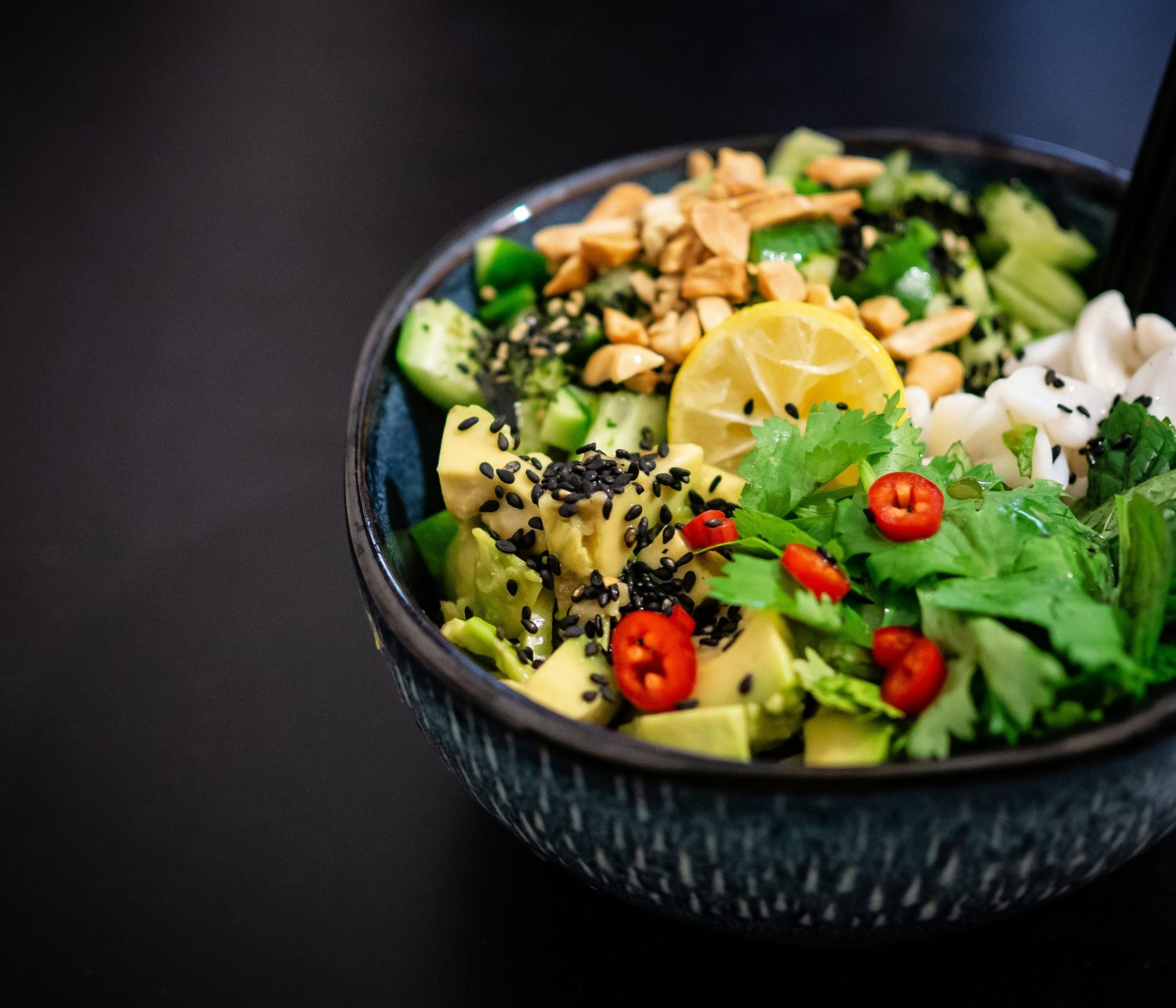The ultimate keto diet plan: A guide
A keto eating plan is a structured approach to the ketogenic diet that consists mainly of high-fat, moderate protein and very low-carb foods. This method of eating has gained popularity as it promises effective weight loss, improved mental clarity and a stabilised blood sugar balance. By achieving a state of ketosis, the body burns fat instead of glucose as its main source of energy, which can have multiple health benefits.

What is the ketogenic diet?
Definition and principles of the ketogenic diet
The ketogenic diet, often referred to as the keto diet, is a diet characterised by a high fat, moderate protein and very low carbohydrate intake. The main aim of this diet is to put the body into a state of ketosis, where it begins to use fat instead of glucose as its primary source of energy.
Principles of the keto diet:
- High fat: about 70-75% of daily calories come from healthy fats such as avocado, nuts, seeds, coconut oil and oily fish.
- Moderate protein intake: Around 20-25% of daily calories come from protein, mainly from sources such as meat, fish, eggs and dairy products.
- Very low carbohydrate intake: Only 5-10% of daily calories should come from carbohydrates, which equates to about 20-50 grams per day. This excludes starchy foods such as bread, pasta and sugar and encourages the consumption of low-carbohydrate vegetables.
Differences to other diets
Low carb diets: While both diets restrict carbohydrate intake, the keto diet is much stricter and emphasises higher fat intake to achieve ketosis. Low carb diets often allow a higher carbohydrate intake and focus less on fat.
Calorie reduction diets: These diets focus on reducing overall calorie intake, regardless of macronutrient distribution. The keto diet aims to change the type of calories (more fat and fewer carbohydrates) in order to influence the metabolism.
Mediterranean diet: This diet emphasises the consumption of healthy fats, whole grains, fruits and vegetables, but does not strictly limit carbohydrate intake or emphasise ketosis.
Vegetarian/vegan diets: These diets exclude animal products (vegan) or reduce them (vegetarian) and can be high in carbohydrates, especially if lots of pulses and grains are consumed. The keto diet can be adapted to vegetarian and vegan principles, but requires careful planning to keep carbohydrate intake low and include sufficient fat and protein.
By following the principles of the ketogenic diet, the body can be put into a state of ketosis, which offers many health benefits, including weight loss, improved mental clarity and stabilised blood sugar balance.

Basics of the keto diet plan
Macronutrient distribution: fats, proteins, carbohydrates
A key aspect of the keto eating plan is the distribution of macronutrients, which aims to put the body into a state of ketosis. The typical macronutrient distribution in a ketogenic diet is as follows:
- Fats (70-75%): The majority of calories come from healthy fats. These fats are crucial to provide the body with energy while minimising carbohydrate intake. Sources of healthy fats include avocado, olive oil, coconut oil, nuts and seeds, and oily fish such as salmon and mackerel.
- Proteins (20-25%): Protein is important for maintaining and building muscle mass, especially for physically active individuals. Good sources of protein include meat, fish, eggs and dairy products. It is important to keep protein intake moderate, as excess protein can be converted into glucose, which can prevent you from entering ketosis.
- Carbohydrates (5-10%): Carbohydrate intake is kept to a minimum, typically around 20-50 grams per day. This means avoiding starchy foods such as bread, pasta and sugar. Instead, low-carbohydrate vegetables such as leafy greens, broccoli and courgettes should be consumed.
Ketosis: the state and how to achieve it
What is ketosis? Ketosis is a metabolic state in which the body uses fat as its main source of energy. This occurs when carbohydrate intake is drastically reduced and the body begins to convert fatty acids into ketones. These ketones then serve as an alternative energy source, especially for the brain, which normally favours glucose.
How do you achieve ketosis? To achieve the state of ketosis, the following steps must be followed:
- Reduce carbohydrate intake: The first and most important step is to drastically reduce your carbohydrate intake to about 20-50 grams per day. This forces the body to look for alternative sources of energy.
- Increase fat intake: An increased intake of healthy fats is necessary to provide the body with sufficient energy. The fats should come from natural, unprocessed sources.
- Moderate protein intake: It is important to consume a moderate amount of protein to support muscle building, but also to avoid converting excess protein into glucose.
- Regular exercise: Physical activity can accelerate the transition into ketosis by depleting glycogen stores faster.
- Monitoring and adjustment: Ketosticks or blood ketone meters can be used to monitor ketone levels to ensure the body remains in ketosis.
Entering ketosis can take a few days to a week, depending on individual metabolic characteristics and strict adherence to the diet. It is important to be patient during this phase and strictly adhere to the macronutrient distribution to achieve the desired results.
Benefits of the ketogenic diet
Weight loss
The ketogenic diet has proven to be extremely effective for weight loss. By drastically reducing carbohydrates and increasing fat intake, the body enters a state of ketosis where it utilises fat as its primary energy source. This leads to more efficient fat burning and a reduction in body fat. Studies show that people who follow a ketogenic diet often lose weight faster and more sustainably than with conventional diets. Another benefit is the reduced feeling of hunger, as high-fat foods keep you feeling fuller for longer and keep blood sugar levels stable.
Improved mental clarity and energy
The ketogenic diet is often associated with improved mental clarity and increased energy. Ketones, which come from burning fat, are an efficient source of energy for the brain. Many people report increased concentration and mental performance once they are in a stable state of ketosis. This cognitive improvement is particularly beneficial for people who perform intense mental work or suffer from brain fog.
Stabilisation of blood sugar levels
Another significant benefit of the ketogenic diet is the stabilisation of blood sugar levels. The low intake of carbohydrates prevents insulin spikes, which leads to a steady flow of energy. This is particularly beneficial for people with type 2 diabetes or insulin resistance, as it can help to better control blood sugar levels and reduce the need for medication. In addition, stabilising blood sugar levels can reduce cravings and lead to an overall better mood and energy.
Due to these multiple benefits, the ketogenic diet is not only considered an effective method for weight loss, but also a sustainable approach to improving overall health and well-being.

Foods in the keto diet plan
Recommended foods
Possible ingredients:
- Meat: Beef, pork, chicken, turkey
- Fish: salmon, mackerel, tuna, sardines
- Eggs: A versatile and protein-rich option
- Healthy fats: avocado, olive oil, coconut oil, nuts and seeds
- Low-carb vegetables: spinach, broccoli, courgette, cauliflower, kale
These foods provide a rich variety of nutrients that support the body in a state of ketosis while providing variety and enjoyment.
Foods that should be avoided
Ingredients to avoid:
- Sugar: In any form, including sweets, cakes, fizzy drinks
- Cereals: Bread, pasta, rice, oatmeal
- Starchy vegetables: potatoes, sweet potatoes, sweetcorn, peas
These foods contain high amounts of carbohydrates, which can bring the body out of ketosis, and should therefore be avoided.
Sample keto diet plan for one week
Breakfast
Monday: Avocado egg dish with spinach
- Ingredients: 2 eggs, 1 avocado, 1 handful of fresh spinach, salt, pepper
- Preparation: Fry the eggs in a pan, add the diced avocado and spinach, season with salt and pepper.
Tuesday: Chia pudding with coconut milk and berries
- Ingredients: 3 tbsp chia seeds, 200 ml coconut milk, a handful of berries
- Preparation: Mix chia seeds and coconut milk, leave to soak overnight in the fridge, garnish with berries.
Wednesday: Scrambled eggs with salmon and avocado
- Ingredients: 3 eggs, 50 g smoked salmon, 1 avocado, salt, pepper
- Preparation: Beat the eggs and fry in a pan, add the salmon and diced avocado.
Thursday: Keto pancakes
- Ingredients: 2 eggs, 50 g almond flour, 1 tsp baking powder, 1 tsp vanilla extract, coconut oil for frying
- Preparation: Mix ingredients, fry in a pan with coconut oil.
Friday: Smoothie
- Ingredients: 1 avocado, 1 handful of spinach, 1 tbsp chia seeds, 200 ml almond milk
- Preparation: Puree all ingredients in a blender.
Saturday: Omelette with cheese and vegetables
- Ingredients: 3 eggs, 50 g grated cheese, 1 handful of diced vegetables (peppers, courgettes), salt, pepper
- Preparation: Beat the eggs, fry the vegetables, add the egg mixture and sprinkle with cheese.
Sunday: Keto yoghurt with nuts
- Ingredients: 200 g Greek yoghurt, a handful of nuts (almonds, walnuts), 1 tsp linseed
- Preparation: Mix yoghurt with nuts and linseed.
Lunch
Monday: Chicken breast with courgette noodles
- Ingredients: 1 chicken breast, 2 courgettes, olive oil, garlic, salt, pepper
- Preparation: Grill the chicken breast, cut the courgettes into noodles using a spiral cutter, fry briefly in olive oil with garlic.
Tuesday: Tuna salad with olive oil and feta
- Ingredients: 1 tin of tuna, 100 g feta, 1 tomato, 1/2 cucumber, olive oil, salt, pepper
- Preparation: Mix the ingredients and season with olive oil, salt and pepper.
Wednesday: Grilled prawns with broccoli
- Ingredients: 200 g prawns, 1 broccoli, olive oil, garlic, salt, pepper
- Preparation: Grill the prawns, steam the broccoli, sauté with olive oil and garlic.
Thursday: Stuffed peppers with minced meat
- Ingredients: 2 peppers, 200 g minced meat, 1 onion, 1 tomato, cheese for gratinating
- Preparation: Hollow out the peppers, fry the minced meat with the onion and tomato, stuff into the peppers and gratinate with cheese.
Friday: Keto burger without a bun
- Ingredients: 1 beef patty, 1 slice of cheese, lettuce leaves, tomato slices, onion rings, avocado
- Preparation: Grill the patty, serve with cheese, lettuce leaves, tomatoes, onions and avocado.
Saturday: Salmon fillet with cauliflower rice
- Ingredients: 1 salmon fillet, 1 cauliflower, lemon juice, olive oil, salt, pepper
- Preparation: Grill the salmon, grate the cauliflower and steam as a rice substitute, season with lemon juice and olive oil.
Sunday: Turkey strips with avocado salad
- Ingredients: 200 g turkey breast, 1 avocado, 1 tomato, 1/2 cucumber, olive oil, salt, pepper
- Preparation: Fry the turkey breast, dice the avocado, tomato and cucumber, mix with olive oil, salt and pepper.
Dinner
Monday: Beef steak with cauliflower rice
- Ingredients: 1 beef steak, 1 cauliflower, butter, salt, pepper
- Preparation: Fry the steak, grate the cauliflower and steam as a rice substitute, season with butter, salt and pepper.
Tuesday: Baked salmon with asparagus
- Ingredients: 1 salmon fillet, 200 g asparagus, olive oil, lemon juice, salt, pepper
- Preparation: Bake the salmon and asparagus in the oven, season with olive oil and lemon juice.
Wednesday: Pork chops with mushrooms
- Ingredients: 2 pork chops, 100 g mushrooms, garlic, olive oil, salt, pepper
- Preparation: Fry the chops, sauté the mushrooms with garlic in olive oil.
Thursday: Chicken breast with avocado salsa
- Ingredients: 1 chicken breast, 1 avocado, 1 tomato, 1/2 onion, lime juice, salt, pepper
- Preparation: Grill the chicken breast, dice the avocado, tomato and onion, mix with lime juice, salt and pepper.
Friday: Tuna steak with courgette noodles
- Ingredients: 1 tuna steak, 2 courgettes, olive oil, garlic, salt, pepper
- Preparation: Grill the tuna steak, cut the courgette into noodles with a spiral cutter and fry.
Saturday: Keto pizza
- Ingredients: 200 g almond flour, 2 eggs, 1 tsp baking powder, cheese, tomato sauce, toppings of your choice
- Preparation: Mix the dough from almond flour, eggs and baking powder, bake and top with tomato sauce, cheese and toppings.
Sunday: Prawn curry
- Ingredients: 200 g prawns, 1 tin of coconut milk, curry paste, vegetables of your choice
- Preparation: Fry the prawns and vegetables, add the coconut milk and curry paste and simmer.
Snacks
Nuts and seeds: Almonds, walnuts, chia seeds Vegetable sticks: celery, peppers, cucumber with guacamole Cheese: cheddar, mozzarella, brie
Recipes and preparation tips
- Avocado egg dish with spinach: fry the eggs in a pan, add the diced avocado and spinach, season with salt and pepper.
- Chia pudding: Mix chia seeds and coconut milk, leave to soak overnight in the fridge, garnish with berries.
- Courgette noodles with chicken: Cut courgettes into noodle shapes using a spiral cutter and fry briefly in olive oil with garlic, add chicken breast.
These detailed plans and recipes offer a comprehensive insight into a balanced and varied keto diet that is not only healthy, but also tasty and filling.

Tips for switching to the keto diet
Common challenges and how to overcome them
Switching to the keto diet can be difficult at first. Carbohydrate cravings, loss of energy and digestive issues are common challenges. Slowly reducing carbohydrates and increasing your intake of healthy fats and proteins can make the transition easier. It is also important to carefully monitor macronutrients and prepare well for meals to avoid temptations.
Tips for avoiding the “keto flu”
The “keto flu” is a common phenomenon in the first few days of the keto diet, caused by the abrupt reduction of carbohydrates. Symptoms can include fatigue, headaches, nausea and irritability. To avoid this, it is important to drink plenty of water and increase electrolyte intake, especially sodium, potassium and magnesium. Consuming broth or savoury snacks can also be helpful.
Hydration and electrolytes
During the keto diet, adequate hydration is crucial as the body loses more water when it is in ketosis. Drink at least 2-3 litres of water daily. Supplement your diet with electrolyte-rich foods or supplements to compensate for the loss of minerals.
Keto and athletic performance
Adapting the diet for active athletes
Athletically active people need to ensure that they have enough energy for their training sessions. Increasing fat intake and sticking to a regular meal plan can help keep energy levels stable. Taking medium-chain triglycerides (MCTs) from coconut oil can be a quick source of energy.
Timing and composition of meals before and after training
Low carbohydrate, high fat snacks such as nuts or cheese should be consumed before training to provide energy. After training, it is important to provide the body with sufficient protein and healthy fats to support muscle recovery. An example of a post-workout meal could be a salmon fillet with avocado and green vegetables.
By adapting their diet and carefully planning their meals, athletes can reap the benefits of the keto diet while maintaining their athletic performance.
Supplements and support from kingnature
Recommended supplements to support the keto diet
During the keto diet, supplements can be helpful to provide the body with necessary nutrients and ease the transition into ketosis. Recommended supplements are:
- Electrolytes: sodium, potassium and magnesium are essential for avoiding the “keto flu”.
- Omega-3 fatty acids: Support heart health and reduce inflammation.
- MCT oil: Provides a quick source of energy and helps with ketosis.
- Vitamin D: Strengthens the immune system and supports bone health.
Products from kingnature to optimise health
kingnature offers a range of high quality supplements specifically designed to support health during the keto diet:
- Omega-3: Rich in EPA and DHA for optimal heart health.
- Magnesium supplements: To support muscle function and prevent cramping.
- Vitamin D3: Promotes immune function and calcium absorption.
By incorporating these supplements, the keto diet can be made more effective and enjoyable, with kingnature products offering excellent quality and efficacy.
Conclusion
The ketogenic diet can provide numerous health benefits, including weight loss, improved mental clarity and stable blood sugar levels. Success depends on careful planning and choosing the right foods. By integrating healthy fats, moderate proteins and few carbohydrates, you can enter the state of ketosis, where your body efficiently utilises fat as an energy source.
Switching to a keto diet plan requires commitment, but can be motivating due to the numerous benefits. It is important to consider individual needs and preferences and be aware that the initial challenges, such as the ‘keto flu’, can be overcome. Gradually reducing carbohydrates and increasing your intake of healthy fats and electrolytes can make the transition easier.
kingnature offers high-quality supplements that can support the keto diet, such as omega-3 capsules, magnesium supplements and vitamin D3. These products help prevent nutrient deficiencies and maximise the health benefits of the ketogenic diet.